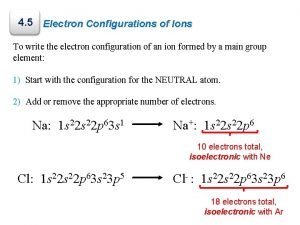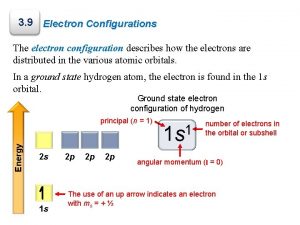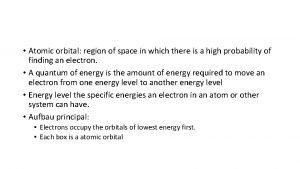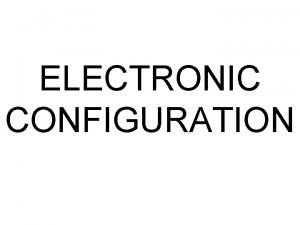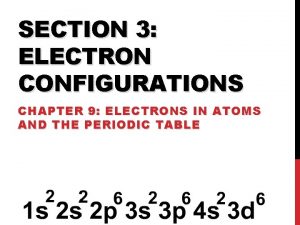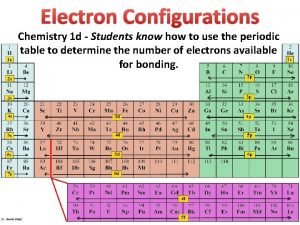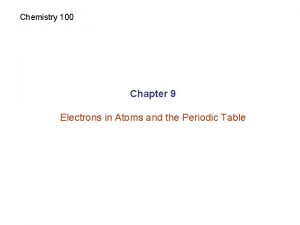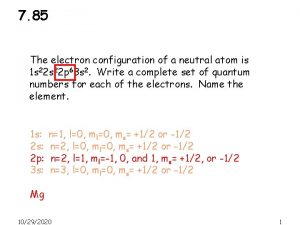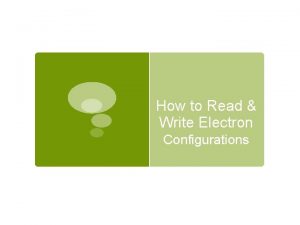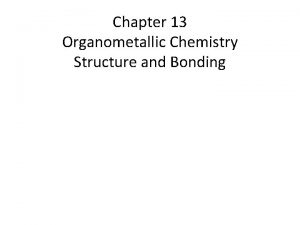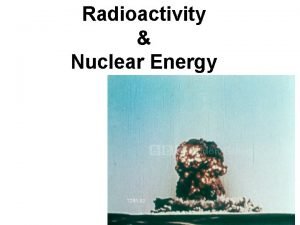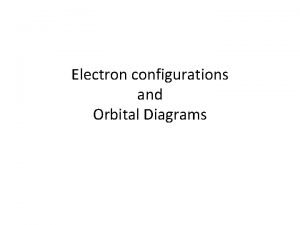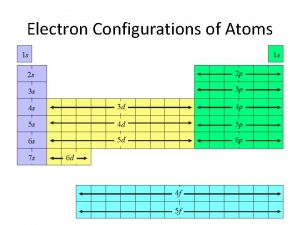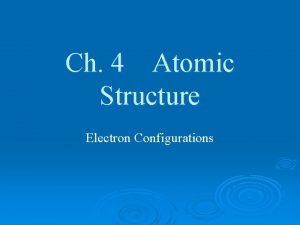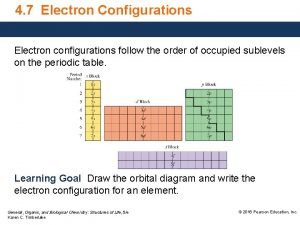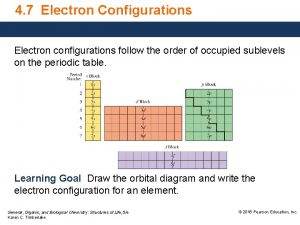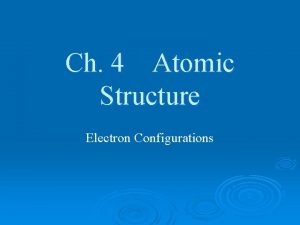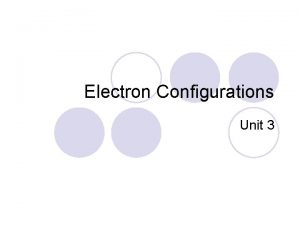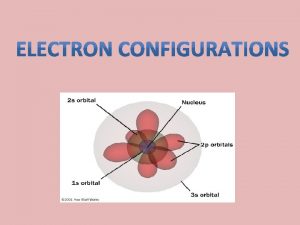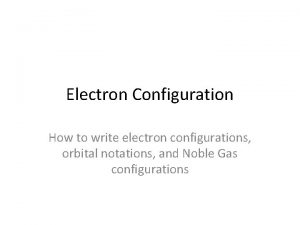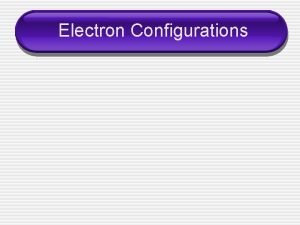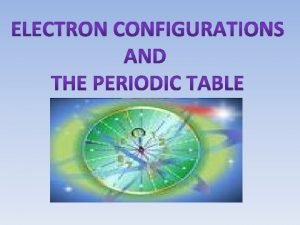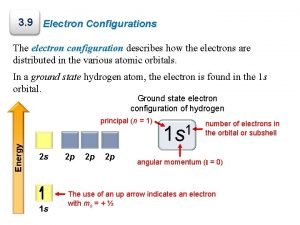Example 8 1 Electron Configurations Write electron configurations



























- Slides: 27

Example 8. 1 Electron Configurations Write electron configurations for each element. a. Mg b. P c. Br d. Al Solution a. Mg Magnesium has 12 electrons. Distribute 2 of these into the 1 s orbital, 2 into the 2 s orbital, 6 into the 2 p orbitals, and 2 into the 3 s orbital. Mg 1 s 2 2 p 6 3 s 2 or [Ne] 3 s 2 b. P Phosphorus has 15 electrons. Distribute 2 of these into the 1 s orbital, 2 into the 2 s orbital, 6 into the 2 p orbitals, 2 into the 3 s orbital, and 3 into the 3 p orbitals. P 1 s 2 2 p 6 3 s 2 3 p 3 or [Ne] 3 s 2 3 p 3 c. Br Bromine has 35 electrons. Distribute 2 of these into the 1 s orbital, 2 into the 2 s orbital, 6 into the 2 p orbitals, 2 into the 3 s orbital, 6 into the 3 p orbitals, 2 into the 4 s orbital, 10 into the 3 d orbitals, and 5 into the 4 p orbitals. Br 1 s 2 2 p 6 3 s 2 3 p 6 4 s 2 3 d 10 4 p 5 or [Ar] 4 s 2 3 d 10 4 p 5 d. Al Aluminum has 13 electrons. Distribute 2 of these into the 1 s orbital, 2 into the 2 s orbital, 6 into the 2 p orbitals, 2 into the 3 s orbital, and 1 into the 3 p orbital. Al 1 s 2 2 p 6 3 s 2 3 p 1 or [Ne] 3 s 2 3 p 1 Chemistry: A Molecular Approach, 3 rd Edition Nivaldo J. Tro © 2014 Pearson Education, Inc.

Example 8. 1 Electron Configurations Continued For Practice 8. 1 Write electron configurations for each element. a. Cl b. Si Chemistry: A Molecular Approach, 3 rd Edition Nivaldo J. Tro c. Sr d. O © 2014 Pearson Education, Inc.

Example 8. 2 Writing Orbital Diagrams Write the orbital diagram for sulfur and determine the number of unpaired electrons. Solution Since sulfur’s atomic number is 16, it has 16 electrons and the electron configuration 1 s 2 2 p 6 3 s 2 3 p 4. Draw a box for each orbital, putting the lowest energy orbital (1 s) on the far left and proceeding to orbitals of higher energy to the right. Distribute the 16 electrons into the boxes representing the orbitals, allowing a maximum of 2 electrons per orbital and remembering Hund’s rule. You can see from the diagram that sulfur has two unpaired electrons. Two unpaired electrons For Practice 8. 2 Write the orbital diagram for Ar and determine the number of unpaired electrons. Chemistry: A Molecular Approach, 3 rd Edition Nivaldo J. Tro © 2014 Pearson Education, Inc.

Example 8. 3 Valence Electrons and Core Electrons Write the electron configuration for Ge. Identify the valence electrons and the core electrons. Solution Write the electron configuration for Ge by determining the total number of electrons from germanium’s atomic number (32) and then distributing them into the appropriate orbitals. Ge 1 s 2 2 p 6 3 s 2 3 p 6 4 s 2 3 d 10 4 p 2 Since germanium is a main-group element, its valence electrons are those in the outermost principal energy level. For germanium, the n = 1, 2, and 3 principal levels are complete (or full) and the n = 4 principal level is outermost. Consequently, the n = 4 electrons are valence electrons and the rest are core electrons. Note: In this book, we write electron configurations with the orbitals in the order of filling. However, electron configurations are sometimes written in order of increasing principal quantum number. The electron configuration of germanium written in order of increasing principal quantum number is Ge 1 s 2 2 p 6 3 s 2 3 p 6 3 d 10 4 s 2 4 p 2. For Practice 8. 3 Write an electron configuration for phosphorus. Identify the valence electrons and core electrons. Chemistry: A Molecular Approach, 3 rd Edition Nivaldo J. Tro © 2014 Pearson Education, Inc.

Example 8. 4 Writing Electron Configurations from the Periodic Table Use the periodic table to write the electron configuration for selenium (Se). Solution The atomic number of Se is 34. The noble gas that precedes Se in the periodic table is argon, so the inner electron configuration is [Ar]. Obtain the outer electron configuration by tracing the elements between Ar and Se and assigning electrons to the appropriate orbitals. Begin with [Ar]. Because Se is in row 4, add two 4 s electrons as you trace across the s block (n = row number). Next, add ten 3 d electrons as you trace across the d block (n = row number − 1). Lastly, add four 4 p electrons as you trace across the p block to Se, which is in the fourth column of the p block (n = row number). Se [Ar] 4 s 2 3 d 10 4 p 4 Chemistry: A Molecular Approach, 3 rd Edition Nivaldo J. Tro © 2014 Pearson Education, Inc.

Example 8. 4 Writing Electron Configurations from the Periodic Table Continued For Practice 8. 4 Use the periodic table to determine the electron configuration of bismuth (Bi). For More Practice 8. 4 Use the periodic table to write the electron configuration for iodine (I). Chemistry: A Molecular Approach, 3 rd Edition Nivaldo J. Tro © 2014 Pearson Education, Inc.

Example 8. 5 Atomic Size On the basis of periodic trends, choose the larger atom in each pair (if possible). Explain your choices. a. N or F b. C or Ge c. N or Al d. Al or Ge Solution a. N atoms are larger than F atoms because as you trace the path between N and F on the periodic table, you move to the right within the same period. As you move to the right across a period, the effective nuclear charge experienced by the outermost electrons increases, resulting in a smaller radius. Chemistry: A Molecular Approach, 3 rd Edition Nivaldo J. Tro © 2014 Pearson Education, Inc.

Example 8. 5 Atomic Size Continued b. Ge atoms are larger than C atoms because as you trace the path between C and Ge on the periodic table, you move down a column. Atomic size increases as you move down a column because the outermost electrons occupy orbitals with a higher principal quantum number that are therefore larger, resulting in a larger atom. Chemistry: A Molecular Approach, 3 rd Edition Nivaldo J. Tro © 2014 Pearson Education, Inc.

Example 8. 5 Atomic Size Continued c. Al atoms are larger than N atoms because as you trace the path between N and Al on the periodic table, you move down a column (atomic size increases) and then to the left across a period (atomic size increases). These effects add together for an overall increase. Chemistry: A Molecular Approach, 3 rd Edition Nivaldo J. Tro © 2014 Pearson Education, Inc.

Example 8. 5 Atomic Size Continued d. Based on periodic trends alone, you cannot tell which atom is larger, because as you trace the path between Al and Ge you go to the right across a period (atomic size decreases) and then down a column (atomic size increases). These effects tend to counter each other, and it is not easy to tell which will predominate. Chemistry: A Molecular Approach, 3 rd Edition Nivaldo J. Tro © 2014 Pearson Education, Inc.

Example 8. 5 Atomic Size Continued For Practice 8. 5 On the basis of periodic trends, choose the larger atom in each pair (if possible): a. Sn or I b. Ge or Po c. Cr or W d. F or Se For More Practice 8. 5 Arrange the elements in order of decreasing radius: S, Ca, F, Rb, Si. Chemistry: A Molecular Approach, 3 rd Edition Nivaldo J. Tro © 2014 Pearson Education, Inc.

Example 8. 6 Electron Configurations and Magnetic Properties for Ions Write the electron configuration and orbital diagram for each ion and determine whether each is diamagnetic or paramagnetic. a. Al 3+ b. S 2− c. Fe 3+ Solution a. Al 3+ Begin by writing the electron configuration of the neutral atom. Since this ion has a 3+ charge, remove three electrons to write the electron configuration of the ion. Write the orbital diagram by drawing half -arrows to represent each electron in boxes representing the orbitals. Because there are no unpaired electrons, Al 3+ is diamagnetic. Al Al 3+ [Ne] 3 s 2 3 p 1 [Ne] or [He] 2 s 2 2 p 6 Diamagnetic Chemistry: A Molecular Approach, 3 rd Edition Nivaldo J. Tro © 2014 Pearson Education, Inc.

Example 8. 6 Electron Configurations and Magnetic Properties for Ions Continued b. S 2− Begin by writing the electron configuration of the neutral atom. Since this ion has a 2− charge, add two electrons to write the electron configuration of the ion. Write the orbital diagram by drawing half-arrows to represent each electron in boxes representing the orbitals. Because there are no unpaired electrons, S 2− is diamagnetic. S S 2− [Ne] 3 s 2 3 p 4 [Ne] 3 s 2 3 p 6 Diamagnetic Chemistry: A Molecular Approach, 3 rd Edition Nivaldo J. Tro © 2014 Pearson Education, Inc.

Example 8. 6 Electron Configurations and Magnetic Properties for Ions Continued c. Fe 3+ Begin by writing the electron configuration of the neutral atom. Since this ion has a 3+ charge, remove three electrons to write the electron configuration of the ion. Since it is a transition metal, remove the electrons from the 4 s orbital before removing electrons from the 3 d orbitals. Write the orbital diagram by drawing half-arrows to represent each electron in boxes representing the orbitals. There are unpaired electrons, so Fe 3+ is paramagnetic. Fe Fe 3+ [Ar] 4 s 2 3 d 6 [Ar] 4 s 0 3 d 5 Paramagnetic For Practice 8. 6 Write the electron configuration and orbital diagram for each ion and predict whether each will be paramagnetic or diamagnetic. a. Co 2+ b. N 3− c. Ca 2+ Chemistry: A Molecular Approach, 3 rd Edition Nivaldo J. Tro © 2014 Pearson Education, Inc.

Example 8. 7 Ion Size Choose the larger atom or ion from each pair. a. S or S 2− b. Ca or Ca 2+ c. Br− or Kr Solution a. The S 2− ion is larger than an S atom because anions are larger than the atoms from which they are formed. b. A Ca atom is larger than Ca 2+ because cations are smaller than the atoms from which they are formed. c. A Br− ion is larger than a Kr atom because, although they are isoelectronic, Br− has one fewer proton than Kr, resulting in a lesser pull on the electrons and therefore a larger radius. For Practice 8. 7 Choose the larger atom or ion from each pair. a. K or K+ b. F or F− c. Ca 2+ or Cl− For More Practice 8. 7 Arrange the following in order of decreasing radius: Ca 2+, Ar, Cl−. Chemistry: A Molecular Approach, 3 rd Edition Nivaldo J. Tro © 2014 Pearson Education, Inc.

Example 8. 8 Ionization Energy On the basis of periodic trends, determine which element in each pair has the higher first ionization energy (if possible). a. Al or S b. As or Sb c. N or Si d. O or Cl Solution a. Al or S S has a higher ionization energy than Al because as you trace the path between Al and S on the periodic table, you move to the right within the same row. Ionization energy increases as you go to the right due to increasing effective nuclear charge. Chemistry: A Molecular Approach, 3 rd Edition Nivaldo J. Tro © 2014 Pearson Education, Inc.

Example 8. 8 Ionization Energy Continued b. As or Sb As has a higher ionization energy than Sb because as you trace the path between As and Sb on the periodic table, you move down a column. Ionization energy decreases as you go down a column as a result of the increasing size of orbitals with increasing n. Chemistry: A Molecular Approach, 3 rd Edition Nivaldo J. Tro © 2014 Pearson Education, Inc.

Example 8. 8 Ionization Energy Continued c. N or Si N has a higher ionization energy than Si because as you trace the path between N and Si on the periodic table, you move down a column (ionization energy decreases) and then to the left across a row (ionization energy decreases). These effects sum together for an overall decrease. Chemistry: A Molecular Approach, 3 rd Edition Nivaldo J. Tro © 2014 Pearson Education, Inc.

Example 8. 8 Ionization Energy Continued d. O or Cl Based on periodic trends alone, it is impossible to tell which has a higher ionization energy because, as you trace the path between O and Cl, you go to the right across a row (ionization energy increases) and then down a column (ionization energy decreases). These effects tend to counter each other, and it is not obvious which will dominate. Chemistry: A Molecular Approach, 3 rd Edition Nivaldo J. Tro © 2014 Pearson Education, Inc.

Example 8. 8 Ionization Energy Continued For Practice 8. 8 On the basis of periodic trends, determine the element in each pair with the higher first ionization energy (if possible). a. Sn or I b. Ca or Sr c. C or P d. F or S For More Practice 8. 8 Arrange the following elements in order of decreasing first ionization energy: S, Ca, F, Rb, Si. Chemistry: A Molecular Approach, 3 rd Edition Nivaldo J. Tro © 2014 Pearson Education, Inc.

Example 8. 9 Metallic Character On the basis of periodic trends, choose the more metallic element from each pair (if possible). a. Sn or Te b. P or Sb c. Ge or In d. S or Br Solution a. Sn or Te Sn is more metallic than Te because as you trace the path between Sn and Te on the periodic table, you move to the right within the same period. Metallic character decreases as we go to the right. Chemistry: A Molecular Approach, 3 rd Edition Nivaldo J. Tro © 2014 Pearson Education, Inc.

Example 8. 9 Metallic Character Continued b. P or Sb Sb is more metallic than P because as you trace the path between P and Sb on the periodic table, you move down a column. Metallic character increases as we go down a column. Chemistry: A Molecular Approach, 3 rd Edition Nivaldo J. Tro © 2014 Pearson Education, Inc.

Example 8. 9 Metallic Character Continued c. Ge or In In is more metallic than Ge because as you trace the path between Ge and In on the periodic table, you move down a column (metallic character increases) and then to the left across a period (metallic character increases). These effects add together for an overall increase. Chemistry: A Molecular Approach, 3 rd Edition Nivaldo J. Tro © 2014 Pearson Education, Inc.

Example 8. 9 Metallic Character Continued d. S or Br Based on periodic trends alone, we cannot tell which is more metallic because as you trace the path between S and Br, you go to the right across a period (metallic character decreases) and then down a column (metallic character increases). These effects tend to counter each other, and it is not easy to tell which will predominate. Chemistry: A Molecular Approach, 3 rd Edition Nivaldo J. Tro © 2014 Pearson Education, Inc.

Example 8. 9 Metallic Character Continued For Practice 8. 9 On the basis of periodic trends, choose the more metallic element from each pair (if possible). a. Ge or Sn b. Ga or Sn c. P or Bi d. B or N For More Practice 8. 9 Arrange the following elements in order of increasing metallic character: Si, Cl, Na, Rb. Chemistry: A Molecular Approach, 3 rd Edition Nivaldo J. Tro © 2014 Pearson Education, Inc.

Example 8. 10 Alkali Metal and Halogen Reactions Write a balanced chemical equation for each reaction. a. the reaction between potassium metal and bromine gas b. the reaction between rubidium metal and liquid water c. the reaction between gaseous chlorine and solid iodine Solution a. Alkali metals react with halogens to form metal halides. Write the formulas for the reactants and the metal halide product (making sure to write the correct ionic chemical formula for the metal halide, as outlined in Section 3. 5), and then balance the equation. 2 K(s) + Br 2(g) → 2 KBr(s) b. Alkali metals react with water to form the dissolved metal ion, the hydroxide ion, and hydrogen gas. Write the skeletal equation including each of these and then balance it. 2 Rb(s) + 2 H 2 O(l) → 2 Rb+(aq) + 2 OH−(aq) + H 2(g) c. Halogens react with each other to form interhalogen compounds. Write the skeletal equation with each of the halogens as the reactants and the interhalogen compound as the product and balance the equation. Cl 2(g) + I 2(s) → 2 ICl(g) Chemistry: A Molecular Approach, 3 rd Edition Nivaldo J. Tro © 2014 Pearson Education, Inc.

Example 8. 10 Alkali Metal and Halogen Reactions Continued For Practice 8. 10 Write a balanced chemical equation for each reaction. a. the reaction between aluminum metal and chlorine gas b. the reaction between lithium metal and liquid water c. the reaction between gaseous hydrogen and liquid bromine Chemistry: A Molecular Approach, 3 rd Edition Nivaldo J. Tro © 2014 Pearson Education, Inc.
 Isoelectronic series
Isoelectronic series Complete ground state electron configuration
Complete ground state electron configuration 1s 22 s22 p63 s23 p64 s2
1s 22 s22 p63 s23 p64 s2 Stable electron configurations are likely to contain
Stable electron configurations are likely to contain Ccechs
Ccechs An orbital is a region of space in an atom where there is
An orbital is a region of space in an atom where there is Stable electronic configuration
Stable electronic configuration Design chart for flexible pavement
Design chart for flexible pavement Icq transistor
Icq transistor What is electronic configuration
What is electronic configuration Electrons configurations
Electrons configurations Electrons configurations
Electrons configurations Electrons configurations
Electrons configurations Uses of bjt
Uses of bjt Ceedar innovation configurations
Ceedar innovation configurations Write the full ground state electron configuration of o+
Write the full ground state electron configuration of o+ Electron configuration how to read
Electron configuration how to read Teknik mapping pada memori
Teknik mapping pada memori What is 18 electron rule with example
What is 18 electron rule with example What is 18 electron rule with example
What is 18 electron rule with example Express electron
Express electron Electron capture example
Electron capture example Orbital diagram
Orbital diagram Thesis statement
Thesis statement How to write a rationale example
How to write a rationale example How to write a report example
How to write a report example Example of claim
Example of claim Timed writing examples
Timed writing examples
